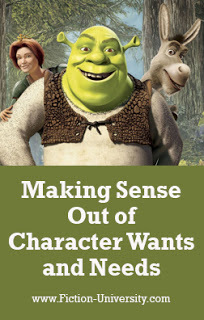Janice Hardy's Blog, page 22
May 29, 2021
WIP Diagnostic: Is This Working? A Closer Look at Finding an Opening that Reflects the Novel
 Critique by Janice Hardy, @Janice_Hardy
Critique by Janice Hardy, @Janice_HardyWIP Diagnostics is a weekly column that studies a snippet of a work in progress for specific issues. Readers are encouraged to send in work with questions, and we diagnose it on the site. It’s part critique, part example, and designed to help the submitter as well as anyone else having a similar problem.
If you're interested in submitting to WIP Diagnostics, please check out these guidelines.
Submissions currently in the queue: Five
Please Note: As of today, critique slots are booked through July 3.
This week’s question:
1. Is this a good "hook" / book opening?
Market/Genre: YA Contemporary with Romantic Elements
On to the diagnosis…
Continue ReadingWritten by Janice Hardy. Fiction-University.com
Published on May 29, 2021 03:00
May 27, 2021
Apply the Tools of Corporate America to Improve the Writing Life
 By Mayonn Paasewe-Valchev, @MayonnValchev
By Mayonn Paasewe-Valchev, @MayonnValchev Part of The Writer’s Life Series
JH: Authors are small business, and applying a business mentality to our writing can benefit us. Mayonn Paasewe-Valchev shares how to use corporate tools to become a better writer.
Mayonn Paasewe-Valchev lives in Georgia with her family and is represented by Sara Megibow of KT Literary. Her debut novel, The Leopard Behind the Moon, is a magical realism for the middle-grade reader – a warm, sweet, beautiful story about friendship, healing, grief, community…and more than one intruding, talking animal. Publication by Greenwillow/HarperCollins is planned for September 2021.
Website | Twitter | Goodreads
Take it away Mayonn…
Continue ReadingWritten by Janice Hardy. Fiction-University.com
Published on May 27, 2021 03:00
May 25, 2021
One Key Question to Ask Before You Start Writing
 By Shanna Swendson, @ShannaSwendson
By Shanna Swendson, @ShannaSwendsonPart of The Writer’s Life Series
JH: Writers write for many different reasons, but there's one reason we don't usually consider when we start a novel. Shanna Swendson discusses this unexpected question every writer should ask when considering a new idea.
Shanna Swendson earned a journalism degree from the University of Texas but decided it was more fun to make up the people she wrote about and became a novelist. She’s written a number of fantasy novels for teens and adults, including the Enchanted, Inc. series and the Rebel Mechanics series. She devotes her spare time to reading, knitting, and music. Her newest novel is the paranormal mystery Interview with a Dead Editor .
Website | Twitter | Facebook | Goodreads
Take it away Shanna…
Continue ReadingWritten by Janice Hardy. Fiction-University.com
Published on May 25, 2021 03:00
May 24, 2021
Making Sense Out of Character Wants and Needs
 By Janice Hardy, @Janice_Hardy
By Janice Hardy, @Janice_Hardy Plot and character arc. External and internal conflict. Intellectual and emotional. There are indeed two sides to every story.
Confusion between a character’s want and need has sent many a writer down the wrong plot path, and I’ve run into quite a few who found themselves puzzled over how to use wants and needs in their novels. Are they the same thing? Is one the plot and the other the subplot? No, and no.
A strong want/need pairing shows an emotional hole in the protagonist’s life, and how resolving the plot allows them to fill that hole.
The protagonist doesn’t always know what they need, but they usually know what they want. That conscious goal (the want) drives the plot. It’s the unconscious goal (the need) that gets realized over the course of the story as the protagonist resolves and experiences that plot. The protagonist “goes through some stuff” and is changed by it. It helps to think of wants as the plot and needs as the character arc.
Continue ReadingWritten by Janice Hardy. Fiction-University.com
Published on May 24, 2021 03:00
May 22, 2021
WIP Diagnostic: Is This Working? A Closer Look at Piquing Reader Curiosity on the First Page
 Critique by Maria D'Marco
Critique by Maria D'MarcoWIP Diagnostics is a weekly column that studies a snippet of a work in progress for specific issues. Readers are encouraged to send in work with questions, and we diagnose it on the site. It’s part critique, part example, and designed to help the submitter as well as anyone else having a similar problem.
If you're interested in submitting to WIP Diagnostics, please check out these guidelines.
Submissions currently in the queue: Six
Please Note: As of today, critique slots are booked through July 3.
This week’s questions:
1. Does this piece provide enough information to make you care?
2. How's the voice? Do you get a sense of the character's personality?
3. Would you read on?
4. Would it throw you when later it is revealed that this character is the villain?
Market/Genre: YA Fantasy
On to the diagnosis…
Continue ReadingWritten by Janice Hardy. Fiction-University.com
Published on May 22, 2021 03:57
May 20, 2021
Emotions and the Body: Less Cliché Ways the Body Responds to Emotional States
 By Bonnie Randall
By Bonnie RandallPart of The How They Do It Series
JH: If a cliché is a cliché for a reason, is it still a cliché? Bonnie Randall shares how common emotional responses actually connect with readers.
The other day I read a writing article that really lambasted authors who ‘overuse’ so-called clichéd emotional responses for their characters. “Readers,” the article said, “are really sick of hearing that someone’s gut dropped when they were startled or that their belly got loose when they were scared.”
I confess my heart sank (heh heh) when I saw this. First, as an author, I get a little shirty when I hear that readers are sick of this or sick of that. The snarky curmudgeon in me says “Well then maybe they should write their own damn books!” Second, though, those so-called clichés exist for a reason.
Continue ReadingWritten by Janice Hardy. Fiction-University.com
Published on May 20, 2021 03:11
May 18, 2021
How to Keep Your Short Story Short
 By Rayne Hall, @RayneHall
By Rayne Hall, @RayneHallPart of the Focus on Short Fiction Series
JH: If you’re used to writing novels, switching to short fiction can be rough. Rayne Hall shares tips on how to keep your word count down.
Shorter stories are quicker to write. This means, you can produce more stories, and multiply your chances of getting them accepted for publication. But stories often expand as we write them, trying to grow into novels, demanding more and more words. How can you keep your short story short?
Here are six techniques professional short story authors use. Apply them when you start plotting your yarn.
1. Condense the time frame.
Let the action play out in the shortest time possible a weekend, an afternoon, perhaps even just an hour. Plots spreading over weeks, months or years tend to grow into novels. Curb this by making everything happen quickly.
Continue ReadingWritten by Janice Hardy. Fiction-University.com
Published on May 18, 2021 03:07
May 17, 2021
How Scene Titles Make It Easier to Write Your Novel
 By Janice Hardy, @Janice_Hardy
By Janice Hardy, @Janice_Hardy This simple step can help keep you from getting stuck in your draft.
A few weeks ago, Laurence MacNaughton wrote about revision, and he said something that made me realize how to use what I’ve been doing in a much more effective way (This is why I love having guest authors on the site—I pick up new tips, too). He was talking about re-outlining your novel, and giving your chapters short, descriptive titles, but my mind took it a step further.
I title all my scenes like this, because it’s easier to search through them later when I’m looking for a particular scene. I use Scrivener, and their format is set up well for scene titles (chapter and act titles, too).
Continue ReadingWritten by Janice Hardy. Fiction-University.com
Published on May 17, 2021 06:17
May 15, 2021
WIP Diagnostic: Is This Working? A Closer Look at a YA Fantasy First Page
 Critique by Janice Hardy, @Janice_Hardy
Critique by Janice Hardy, @Janice_Hardy WIP Diagnostics is a weekly column that studies a snippet of a work in progress for specific issues. Readers are encouraged to send in work with questions, and we diagnose it on the site. It’s part critique, part example, and designed to help the submitter as well as anyone else having a similar problem.
If you're interested in submitting to WIP Diagnostics, please check out these guidelines.
Submissions currently in the queue: Five
Please Note: As of today, critique slots are booked through June 19.
This week’s questions:
1. Is this a good opening scene? Would you pay to read on, if this were a genre you liked?
2. Is Prentice (the MC) likeable? Can you empathize with her?
3. Are the stakes big enough for a YA novel?
4. Prentice's family is Chinese/British and they live in the UK. Is this setting clear or confusing? (Might I need to say they're in London, for example.)
5. Is there too much information in this scene for the reader to process?
6. Is the voice right for YA?
Market/Genre: Young Adult Fantasy
On to the diagnosis…
Continue ReadingWritten by Janice Hardy. Fiction-University.com
Published on May 15, 2021 05:35
May 14, 2021
The Ins and Outs of Coauthoring as an Indie Author
 By Cassie Alexander, @CassieY4
By Cassie Alexander, @CassieY4Part of The Indie Author Series
JH: Writing with another author can be a rewarding experience, but how exactly does it work? Cassie Alexander discusses how to handle a coauthorship.
Cassie Alexander is a registered nurse and author. Her most recent book is Dragon Called , cowritten with Kara Lockharte, and they also write together as Cassie Lockharte. Prior to that, she wrote the five-book Edie Spence urban fantasy series, out now through St. Martin's Press, and the Dark Ink Tattoo series, a sultry urban fantasy about vampires in Vegas. Join her mailing list for news about her latest releases.
Website (Cassie) | Website (Kara) | Website (Cassie Lockharte) | Goodreads | Facebook | Twitter | Mailing List
Take it away Cassie…
Continue ReadingWritten by Janice Hardy. Fiction-University.com
Published on May 14, 2021 04:16



